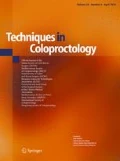Buccal mucosal grafts (BMG) are traditionally used in urethral reconstruction [1]. There may be insufficient BMG for applications requiring large grafts, such as urethral stricture after gender-affirming phalloplasty. If rectal mucosa is used, there is less postoperative pain, no oral impairment, and grafts can be larger [2, 3]. Laparoscopic transanal minimally invasive surgery (TAMIS) has been described for many applications [4]. Due to technical challenges of harvesting a sizable graft within the lumen, we adopted a new robotic approach, which has been shown to be safe and feasible. To our knowledge, this is the first use of robotic TAMIS (R-TAMIS) for rectal mucosa harvest.
This procedure is performed in the lithotomy position with a 30° scope, two instrumented robotic arms, and an assistant port. Key features of the technique include: (1) consistent insufflation of the rectum and colon to 12–15 mmHg to avoid luminal collapse; (2) distal-to-proximal measurement of the desired length of mucosa and scoring of the area prior to dissection; (3) interval injection of lidocaine with epinephrine solution to raise and hydrodissect the mucosal plane and minimize bleeding; (4) dissection to submucosal plane and elevation of the flap with gentle blunt dissection and cautery; (5) retraction of the flap by suture placement for unobstructed view; (6) resulting mucosal defect left to heal by secondary intent to avoid stricture; and (7) post-surgical sigmoidoscopy to inspect for injury and complete hemostasis.
The attached video demonstrates our technique of R-TAMIS in the harvest of rectal mucosa. None of the six patients on whom we have performed this procedure have had intra- or postoperative rectal complications. In all cases, graft size and quality were sufficient for the intended subsequent onlay graft urethroplasty.
References
Lumen N, Oosterlinck W, Hoebeke P (2012) Urethral reconstruction using buccal mucosa or penile skin grafts: systematic review and meta-analysis. Urol Int 89(4):387–394
Browne BM, Vanni AJ (2017) Use of alternative techniques and grafts in urethroplasty. Urol Clin North Am 44(1):127–140
Palmer DA et al (2016) Urethral reconstruction with rectal mucosa graft onlay: a novel, minimally invasive technique. J Urol 196(3):782–786
Martin-Perez B et al (2014) A systematic review of transanal minimally invasive surgery (TAMIS) from 2010 to 2013. Tech Coloproctol 18(9):775–788
Author information
Authors and Affiliations
Corresponding author
Ethics declarations
Conflict of interest
The authors declare that they have no conflict of interest.
Ethical approval
All procedures performed in the study involving human participants were in accordance with the ethical standards of the Trust and with the 1964 Helsinki declaration and its later amendments or comparable ethical standards.
Informed consent
Written informed consent was obtained from all patients for publication of the accompanying images.
Additional information
Publisher's Note
Springer Nature remains neutral with regard to jurisdictional claims in published maps and institutional affiliations.
Electronic supplementary material
Below is the link to the electronic supplementary material.
Supplementary material 1 (mov 2,55,965 kb)
Rights and permissions
About this article
Cite this article
Howard, K.N., Zhao, L.C., Weinberg, A.C. et al. A novel surgery: robotic transanal rectal mucosal harvest. Tech Coloproctol 23, 691 (2019). https://doi.org/10.1007/s10151-019-02008-8
Received:
Accepted:
Published:
Issue Date:
DOI: https://doi.org/10.1007/s10151-019-02008-8

